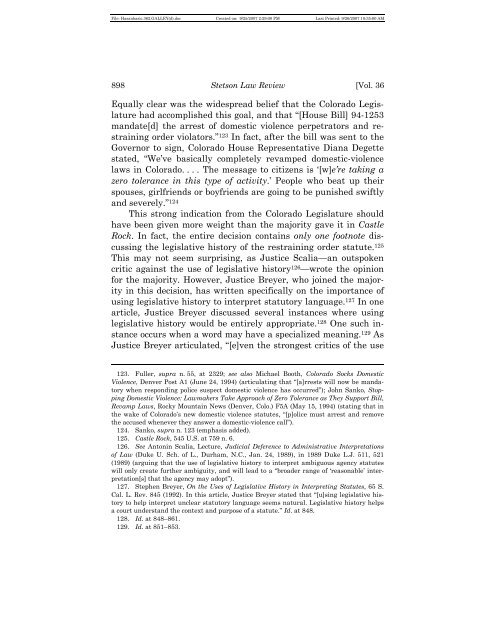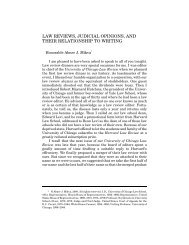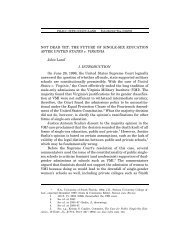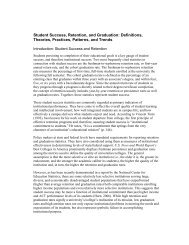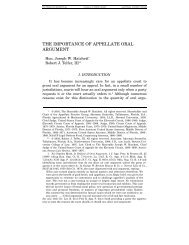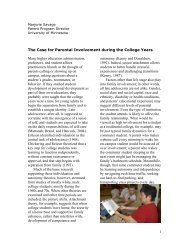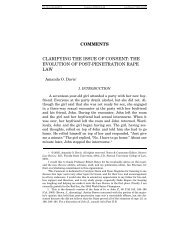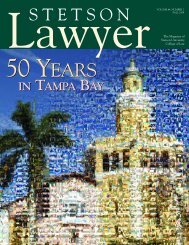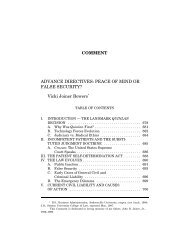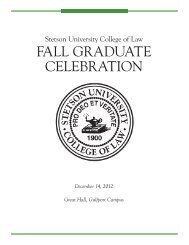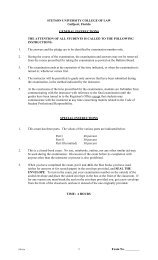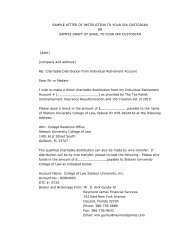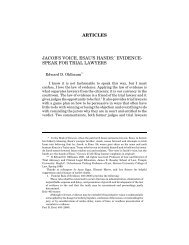TOWN OF CASTLE ROCK v. GONZALES: THE ... - Stetson University
TOWN OF CASTLE ROCK v. GONZALES: THE ... - Stetson University
TOWN OF CASTLE ROCK v. GONZALES: THE ... - Stetson University
You also want an ePaper? Increase the reach of your titles
YUMPU automatically turns print PDFs into web optimized ePapers that Google loves.
File: Hasanbasic.362.GALLEY(d).doc Created on: 9/25/2007 2:29:00 PM Last Printed: 9/26/2007 10:35:00 AM898 <strong>Stetson</strong> Law Review [Vol. 36Equally clear was the widespread belief that the Colorado Legislaturehad accomplished this goal, and that “[House Bill] 94-1253mandate[d] the arrest of domestic violence perpetrators and restrainingorder violators.” 123 In fact, after the bill was sent to theGovernor to sign, Colorado House Representative Diana Degettestated, “We’ve basically completely revamped domestic-violencelaws in Colorado. . . . The message to citizens is ‘[w]e’re taking azero tolerance in this type of activity.’ People who beat up theirspouses, girlfriends or boyfriends are going to be punished swiftlyand severely.” 124This strong indication from the Colorado Legislature shouldhave been given more weight than the majority gave it in CastleRock. In fact, the entire decision contains only one footnote discussingthe legislative history of the restraining order statute. 125This may not seem surprising, as Justice Scalia—an outspokencritic against the use of legislative history 126 —wrote the opinionfor the majority. However, Justice Breyer, who joined the majorityin this decision, has written specifically on the importance ofusing legislative history to interpret statutory language. 127 In onearticle, Justice Breyer discussed several instances where usinglegislative history would be entirely appropriate. 128 One such instanceoccurs when a word may have a specialized meaning. 129 AsJustice Breyer articulated, “[e]ven the strongest critics of the use123. Fuller, supra n. 55, at 2329; see also Michael Booth, Colorado Socks DomesticViolence, Denver Post A1 (June 24, 1994) (articulating that “[a]rrests will now be mandatorywhen responding police suspect domestic violence has occurred”); John Sanko, StoppingDomestic Violence: Lawmakers Take Approach of Zero Tolerance as They Support Bill,Revamp Laws, Rocky Mountain News (Denver, Colo.) F5A (May 15, 1994) (stating that inthe wake of Colorado’s new domestic violence statutes, “[p]olice must arrest and removethe accused whenever they answer a domestic-violence call”).124. Sanko, supra n. 123 (emphasis added).125. Castle Rock, 545 U.S. at 759 n. 6.126. See Antonin Scalia, Lecture, Judicial Deference to Administrative Interpretationsof Law (Duke U. Sch. of L., Durham, N.C., Jan. 24, 1989), in 1989 Duke L.J. 511, 521(1989) (arguing that the use of legislative history to interpret ambiguous agency statuteswill only create further ambiguity, and will lead to a “broader range of ‘reasonable’ interpretation[s]that the agency may adopt”).127. Stephen Breyer, On the Uses of Legislative History in Interpreting Statutes, 65 S.Cal. L. Rev. 845 (1992). In this article, Justice Breyer stated that “[u]sing legislative historyto help interpret unclear statutory language seems natural. Legislative history helpsa court understand the context and purpose of a statute.” Id. at 848.128. Id. at 848–861.129. Id. at 851–853.


